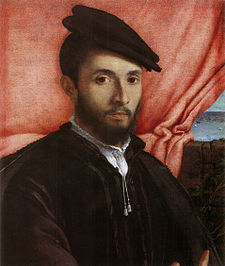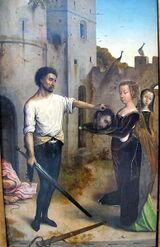Markus I of Korstadt
|
| ||||||||||||||||||||||||||||||||||||
Markus Otto Kortrevich 'The Chancellor' (Common: Marcus Otto Kortrevich), known formally as The Margrave of Korstadt, or referred to simply as Markus. He was the second patriarch of House Kortrevich, succeeding his father in 1738. He was the first and only son of Baron Otto and Kaitlyn Kortrevich. He was the twenty-third Lord Palatine of Haense, assuming the position in 1741. He is regarded for House Kortrevich’s resurgence in the mid 1700s.
Contents
Early Life and Young Adulthood
Markus Otto Kortrevich (1719-1793) was born to Otto and Kailyn Kortrevich as an only child within the Royal City of Old Reza, Haense. As the sole son of Otto Kortrevich, it was his birthright to succeed his father as patriarch of his House. Markus grew up in a time of turmoil as various nations were pitted against each other during the large-scale conflict known as the War of Two Emperors. With his father’s attention focused on the war effort, his father was absent in much of his upbringing. He was notably raised by the likes of Terrence May and his elder kin.
Throughout his adolescence, he was trained by his father in swordsmanship, archery and horseback riding. Despite this, Markus was drawn to politics through his tutelage underneath statesmen Terrence May. As he neared his twenties, he served as Deputy Palatine underneath Lord Palatine Konrad Stafyr. Through his early twenties, Markus would represent the Crown in various duma sessions and began to be seen as a fresh glimpse of what the next generation of Haeseni lords had to offer.
Marriage
In 1732, Markus was betrothed to the daughter of Count Konrad Stafyr, Isabel. Though, Markus suddenly took a fondness for the Princess of Muldav, Winnifred Alimar. In recognition of this, Markus’ father acknowledged both his son’s affinity towards the young Alimar and that a union to House Alimar would be more beneficial than a union to the ancient House Stafyr. The future Count Erich Stafyr was enraged by the notion and began to make preparations for a feudal conflict between the two houses. Those preparations amounted to nothing. Despite this, the current Count of Nenzing, Konrad at the time, allowed the betrothal to be broken off and instead made it so Sigmar Baruch would succeed him as Lord Speaker over Markus.
Years later, Markus Kortrevich married Dame Winnifred Alimar in the Principality of Muldav, officiated by a local Haeseni priest. This marriage strengthened the bond between the houses of Alimar and Kortrevich. Like most marriages backed by political means, their marriage was by no means amicable. Nevertheless, the pair would go on to have two children, Viktor and Juliyus. During the latter years of their marriage, it was rumored that Markus engaged in several adulterous affairs with various women. These rumors wouldn’t be revealed until his wife’s death in 1756. Markus remained a widower for the remainder of his life, choosing not to remarry.
Margrave of Korstadt
After inheriting his House at the age of nineteen following his father’s abdication, Markus quickly settled into his responsibilities as patriarch and was determined to restore his House’s reputation following the defeat of the War of Two Emperors. Furthermore he was determined to grow his House’s influence far beyond the confines of the military. From 1738 to 1741, Markus oversaw the restoration of Fort Korstadt as it fell vacant for a number of years. In doing so, the fortress was once again used as an active military outpost. These efforts proved to be somewhat short-lived as nine years later, the fortress was decommissioned and torn down, following the city’s expansion south.
During the early years of his reign as patriarch, he emphasized the importance for his House to expand outside the military and into the Haeseni government. While this emphasis was clear, he knew the importance of a presence within the military. Notably, the positions of Lord Palatine, High Seneschal and Knight Paramount were occupied by House Kortrevich from 1740 to 1752. In concert, Markus gained favor with both Andrew III and Andrew IV. This brought about a resurgence of Centralism, prompting his subsequent elevation as Leader of the Centralist Party.
Within just seven years as patriarch, he oversaw the elevation of his House with the Margraviate title of Korstadt; a title his House would maintain for nearly six decades. As a result, House Kortrevich once again solidified itself as one of the leading houses within Haeseni nobility. Despite his many successes, including the continued success of the Kortrevich and Amador Trading Company and the repaired reputation of his House, Markus would face failures during his latter tenure as Lord Palatine, costing his own reputation to be looked upon unfavorably. One of the direct results of these failures is the initiation of the feud between the houses of Barclay and Kortrevich; Markus is often regarded as the initial perpetrator of the feud. After twenty years as patriarch, Markus served as Leader of the Centralist Party, Lord Palatine and Knight Paramount. By his son’s seventeenth nameday, Markus willingly abdicated, prompting his son to succeed him in 1758.
Lord Palatine of Haense
Prior to his ascension to the Palatial office, Markus, a self described stephanian-centralist served for three years as Deputy Palatine underneath Lord Palatine Konrad Stafyr. During this time he grew a close rapport with Andrew III. As Konrad Stafyr resigned to Nenzing, Markus was appointed as the twenty-third Lord Palatine of Haense. In his first year as Palatine, Markus captured and executed Ruberni commander Brutus of Morr. This caught many by surprise and sparked equal praise and criticism for both his explicitness and his recklessness in what was already beginning to be a relentless war. After this moment, he would be dubbed, ‘the Bull.’
Early on in his tenure, he prioritized domestic issues over foreign affairs. From 1741 to 1744, Markus rebuilt the Centralist-majority in the Royal Duma and began to pass meaningful legislation, including; the reformation of the defunct academic sector and the reformation of the Kingdom’s military and tax code. Successfully, he founded the first university, called the St. Charles University of Reza and rewrote the Kingdom’s strict tax code; providing relief for the working class. The academy remained functioning for eight years till it eventually collapsed due to lack of funding. Many years later, the Kingdom’s academic sector would see a resurgence under his son, Viktor.
In the midst of the Rubern War, his administration came under siege by rival feudalist opponents. From 1748 to 1749, Markus halted all government projects, including the controversial canal project promulgated by former Lord Palatine Terrence May. Additionally, Markus suspended the Royal Duma and the Aulic Court to focus on the war-effort. In response, the feudalist majority called and passed a sudden vote of no confidence against him. In a turn of events, Andrew III ignored the wishes of the majority and left him in control of the government. A few weeks later, Markus survived an assassination attempt, often believed to be orchestrated by a disgruntled feudalist.
Towards his latter years in office, Markus achieved both successes and failures. Notably, Markus oversaw the controversial firing of Wilheim Barclay as Lord Marshal. This caused the beginnings of the Barclay and Kortrevich feud that would last many years. Contrarily, from 1748 to 1752, Markus as the Leader of the Centralist Party managed to rebuild the Centralist-majority in the Royal Duma for a second time. This would remain till his resignation a few months later.
During the onslaught of the Rubern War, Markus was held in captivity as a prisoner of war for three months. After refusing to have the Kingdom negotiate with the Ruberni, Markus was beaten and tortured ruthlessly. He managed to survive after the Haeseni military organized a rescue raid. In 1752, Ser Tiberius Barrow was elevated as Lord Regent following Andrew IV’s unexpected death. The same year, Markus resigned and was succeeded by Georg Alimar. In doing so, Markus left him the inheritance of a growing economy, strong military and an expanding working class.
Knight Paramount of Hanseti-Ruska
During the Rubern War, Markus heroically saved both his wife and two sons from bandits affiliated with the Alliance of Independent States. In 1750, Andrew IV knighted Markus into the Order of the Crow for these heroic acts. Following his resignation as Lord Palatine in 1752, Markus remained as patriarch of his House for an additional six years till he abdicated to his eldest son, Viktor. Though, for the waning years of his public service, he was appointed as Knight Paramount by Lord Regent Tiberius Barrow on an interim-basis for two years. In his short tenured stint as Knight Paramount, Markus commissioned the dissolution of the Order of the Golden Gryphon after its decentralization caused discontent amongst the ranks of Knights. Two years following, he was succeeded by Ser Jonathan Frostfire.
Later Life and Death
Unfortunately, the same year he concluded his public service, his wife of sixteen years passed away after being diagnosed with tuberculosis a few years prior. While filled with both grief for his wife’s passing and guilt for his failures during their marriage, he made it his life’s mission to find a cure for the untreatable disease. From 1756 to 1790, he ventured to various continents in search of a cure for tuberculosis. Despite his good-willed efforts, they came to no avail. After many years away from home, he returned home at the age of seventy-one. Before his death, he would represent his House in duma for a final time. Three years later in 1793, Markus Kortrevich died of natural causes at the age of seventy-four.
Titles, Styles and Honors
Titles and Styles
- 1741-1752: His Excellency, Lord Palatine of Hanseti-Ruska
- 1754-1756: His Excellency, Knight Paramount of Hanseti-Ruska
- 1745-1758: The Most Honorable, Margrave of Korstadt
- 1738-1758: His Lordship, Baron of Koravia
Formal Title The formal title of Markus is: Lord Markus Kortrevich, Lord Palatine of Hanseti-Ruska, Knight Paramount of Hanseti-Ruska, Margrave of Korstadt, Baron of Koravia.
Issue
| Name | Birth | Death | Marriage | Notes |
|---|---|---|---|---|
| Viktor I, Margrave of Korstadt | 1742 | 1840 | Marya of Ayr | First-born child of Markus I and Winnifred Alimar. Successor of Markus I. |
| Juliyus of Kortrevich | 1745 | 1840 | Katerina vas Stavovic | Second-born son of Markus I and Winnifred Alimar.
|



